2nd September:
With a weekend of guided days out planned in
East Anglia and a place to crash on the Friday night, it seemed rude not to
head up early and attempt some ornithological action beforehand.
I left home at 1030 and made good time north (seeing an Osprey over the M11 between Harlow and Stansted!) and had randomly
messaged the Prof W and intimated that I may visit Mildenhall for a cuppa on my
way up. Traffic on the A11 approaching Barton Mills saw me veer off towards
Tuddenham and therefore a short walk onto Cavenham Heath. I was hoping to find some of the regular
autumnal gathering of Stone Curlews and was pleased to find seven in the same
bit of land where I last saw them here probably ten years ago!
 |
| Stone Curlews - there are at least six in this shot! |
Needless to say they were a little hazy as the morning low
cloud had burnt off to a brilliant blazing afternoon which saw me seeking shady
patches! There were no Woodlarks or
Chats but I was surprised to find four Yellow Wagtails in amongst the Heather
while three long tailed Grey Wagtails flew over towards the river.
I could hear a few Chiffchaffs and a Green Woodpecker and Migrant
Hawkers, Common and Ruddy Darters zoomed around.
 |
| Ruddy Darter |
 |
| A heavily laden Oak that had not yet shed its crop like many others |
A message asking whether I liked crab had me retracing my
steps to my Mildenhall lunch (not just coffee) appointment. I have not seen Mr and Mrs Prof for many a
moon and had a splendid lunch in their flat catching up and reminiscing as you
will have seen from my Thirty Years Ago posts, Paul was a part of many of them.
A guided tour of the official Prof Patch gave me Kingfisher,
Grey Wagtails and even a couple of late Swifts along with the usual three
Dragons and four Willow Emeralds too along the river that flows under the old
mill in which they live.
My brief visit soon became four hours and it was then time
to wend my may to Angie’s in Wymondham for the evening where more post Costa
Rica catching up occurred along with a late omelette.
With only Angie and Pat on my tour the following morning and
a very quiet Norfolk coast, there was no real need for a super early start the
next day.
3rd September:
A leisurely start that even allowed for coffee in the garden
and three garden ticks with two Grey Wagtails, four Golden Plover and a
surprising Treecreeper that flew over the house! Jackdaws and Starlings were the dawn chorus
before it was time to moved moth through the quiet countryside to our random
meet point in Kelling.
I had chosen the Quags and its associated old hedge and
brambles as a better site to randomly look for migrants rather than the overly impenetrable
Holkham this early in the season. The
short wait for Pat to arrive may have accidentally allowed some splendid figs to
tumble into our possession while hoards of presumably local House Martins and a
few Swallows swirled over our heads. I
allowed Pat a recuperative coffee before we headed off (he still managed to
leave the keys in the ignition though) and we poodled down the lane with a wall
of insect sound emanating from the banks of flowering Ivy. Common Wasps, Honey Bees and stripy Ivy Bees dominated
along with the odd Bumble and Syrphus Hoverfly and a couple of Mesembrina meridiana. There were Red Admirals, Speckled Woods, Whites and Commas in attendance too.
 |
| Ivy Bee - Colletes hedera |
 |
| Ivy Bee - Colletes hedera |
 |
| Blackberries to go with the Figs |
 |
| Pendulous strobiles of Hop - I can feel Antony scanning this pic for folds |
 |
| Red Admiral |
Birds were initially few with just the odd calling
Chiffchaff and a Lesser Whitethroat while Goldfinches and Greenfinches moved
between the Bramble clumps. Grey
Partridges could be heard in the field but were too close for us to see while a
great covey of Red-legged Partridges skimmed our heads as the moved from the
crop to ploughed field.
 |
| Red-legged Partridges |
The pool was still very wet with a few attendant duck
including three Wigeon and a Green Sandpiper fed around the margin. A single Stonechat and Whinchat appeared
alongside with three Whitethroats in tow and I was beginning to wonder if I
would actually see a UK Whinchat this year.
 |
| Whinchat |
 |
| Whinchat |
 |
| Egyptian Geese |
We bumped into Chris (a Lesvos regular I had not seen in years) and he had just seen a Wryneck around the corner that Dom
Mitchell had apparently found the night before but it was in a large sloping
field of low dense Bramble and I did not favour our chances so after a chat
with Guy and the Gantletts we made our way to the beach for a seawatch.
A pale headed juvenile Arctic Skua was immediately seen but
to be honest that was that bar a couple of Gannets, Sandwich, Common and two
juvenile Arctic Terns. The fence line alongside us was however quite productive with
both chats again and a bright Willow Warbler that was flycatching while a
Wheatear bounded west along the shingle bank.
Flocks of Curlew headed I the same direction and two Greenshank
circled but did not stop and an adult and almost 1w Med Gull lazily anted
above. Checking a Little Egret in a channel on the Quags allowed Angie to find a perched Kingfisher for us.
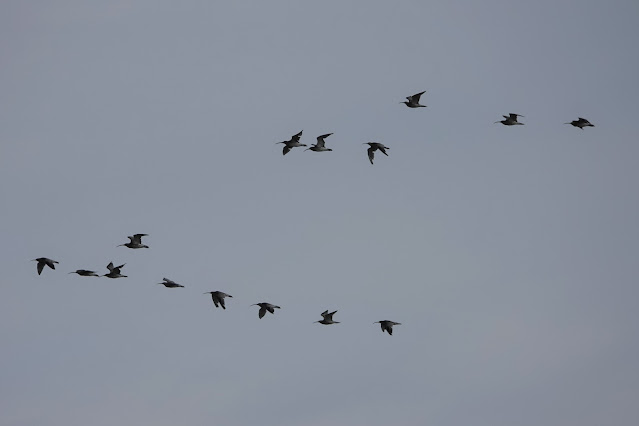 |
| Curlew |
 |
| Med Gull - still pretty much a juv. |
Back at the Wryneck there had been no sign so we started to
walk back when a chance glance back showed the small gathering marching off. We
had just missed it and therefore gave it another twenty minutes before again
getting back to the pool where we were happily watching a variety of Darters
that included a couple of Red-veined when I foolishly (or perhaps not) look
back to the birders 75 yards away to see some intent scope viewing. They had it
once again so a quick trot back (sorry Pat) at last gave us a couple of very
satisfactory minutes as it perched up and chilled in the unexpected sunshine on
a Bramble loop.
 |
| Wryneck |
I promised no more double backs after this especially as we
were all cooking. The Bee noise was even
more impressive on the way back and we at last added Blackcap to the list while
two juvenile Marsh Harriers and several Buzzards were noted above. A large
Devil’s Coach Horse on the path had not folded its coppertone wings away and it
looked most strange. I had not seen this
before and did not know that they all in fact have intricately folded wings
under their short dark elytra.
 |
| Common Buzzard |
 |
| Devil’s Coach Horse |
 |
| Helophilus pendulus |
 |
| A random but beautiful Potato growing in the hedge |
 |
| Robin's Pin Cushion |
Those we left back at the Wryneck all came past us chasing
news of an Icterine Warbler at Gramborough Hill which was our next stop anyway
but the lure of a tea and cake was too great and we patronised the Old Reading
Room Café for a pot that magically extruded ten cups of revitalizing tea and a slabs of ginger cake that
could have (but wouldn’t have) been shared with others!
Replete and rehydrated we made our way the mile to Beach
Road at Salthouse and walked down to the ‘hill’ and it spartan bushes passing some windblown
flowering Sea Aster on the way complete with our second Colletes of the day
with the species tied to this plant. Samphire
was tasted and Sea Lavender and Spartina was in flower and Pied Wagtails and
Meadow Pipits chased each other across the meadows where a Common Sandpiper
called.
 |
| Sea Aster Mining Bee- Colletes halophilus |
 |
| Sea Aster Mining Bee- Colletes halophilus |
 |
| Sea Aster Mining Bee- Colletes halophilus |
 |
| Micro clump of Sea Aster |
 |
| Sea Lavender and Samphire |
 |
| Spartina anglica I believe |
The Icterine Warbler had been very difficult but we chose
the right time to arrive as within a few minutes it came right out in the open
and foraged in the Sallow, clumsily falling from the branches in that classic
Hippo was. It was not an overly bright
bird but it was very well marked with a good pale wing panel and tertial
edges. The throat had a good pale lemon
cast and the legs were a good steely grey.
Angie was particularly pleased as she had not seen one before.
 |
| Icterine Warbler |
A Pied Flycatcher was the only other bird in the clump and
had found the bathing pool created underneath before perching for a while to
dry back off. With success so quickly gained we went back for lunch that may
have included some Figs. Med Gulls of all ages circled around – how things
change.
 |
| Random Star Wars observation - Don't fall into the Figgy Sarlacc Pit!! |
I was surprised to find space in the East Bank car park at Cley
and after noting the darkening sky out to sea (which would pass us by), we
started to walk down the bank. A check
of the Serpentine and back pools added a huge selection of waders to the day
pushing us ever closer to the hundred mark.
There were Dunlin, Blackwits, Ruff, Little Ringed Plovers, loads of
stripy energetic Snipe and at least five juvenile Curlew Sandpipers. The first few spots appeared and a glance
south east suggested that we may have been watching the wrong bit of sky as
within seconds it was hammering down and we had to beat a hasty retreat to the
cars where we hid for the next half an hour.
It was proper big drop rain and it lashed down merrily.
 |
| Curlew Sandpipers |
At last it passed and we headed back out picking up a stray
Andrew Cox who was on a circuit from the village. The waders were much the same although we did
add Grey and Ringed Plover. The swirling
mass of Sandwich Terns on Arnold’s Marsh held a couple of Common Terns and the
closest reeds was literally pinging with Bearded Tits who seemed particularly
active after the deluge.
 |
| Sandwich Terns |
 |
| A lolloping Brown Hare |
A Pied Flycatcher was found almost at my feet making damp
sorties into the grass before flicking into the Phragmites where a Reed warbler was
also noted. Apparently within half an
hour it had made it all the way back to the car park where hopefully it would
find shelter and sustenance in the wood over the road.
 |
| Pied Flycatcher |
A 1w Caspian Gull stood tall on the pools and offshore I
picked up a couple of 1w Yellow-legged Gulls around a bait ball frenzy of other
large Gulls, juvenile Med and Common Gulls, three Gannets and a melee of Terns that included at least one more
juvenile Arctic. The only Skuas seen where
Arctics with three juvs and a pale adult noted.
One successfully removed a large sand eel from a Sandwich Tern only to
have the Tern doggedly chase it back down but by then the Skua had swallowed
its prize. Single Fulmars and Whimbrel
were seen and three silvery Sanderling moved east close inshore.
 |
| Gannet |
Andrew left us to continue on his way and we retraced our
steps slowly to the car with 5pm somehow looming. A presumed female Curlew sedately fed in a pool right alongside and was oblivious to our presence and a Water Rail squealed on the last pool and
became the last bird of the day which had seen us encounter nearly 110 species with
the majority on just a two and a bit mile stretch of coast on an unprepossessing
‘quiet’ Indian summer day…
 |
| Curlew |
 |
| Curlew |
It was a quiet run back to Wymondham and then I headed
straight on south east on a superb cross country route to the Wrens at Lowestoft
where I would be spending the evening before Sunday on the Suffolk coast. A GnT may have helped with sleep…
4th September:
Up at six to find Antony in the garden with his moths, a cup
of tea already waiting for me (thanks Sarah) and Aidan already ensconced on the
sofa. Breakfast was taken with moths
including a new one for his garden – a Feathered Gothic along with some other
smart looking Macros including Setaceous Hebrew Characters, Straw Underwings
and Bright-line Brown Eye, Flounced and Square Spot Rustic and L-album Wainscot. Willow Beauties, Common Carpets and a Toadflax
Pug were on the wall while a Scaeva pyrausti hover was in the ‘meadow’. I failed as usual to add any bird species to Antony’s
garden list so it was 3-0 to Angie for the weekend.
.jpg) |
| Feathered Gothic |
.jpg) |
| Feathered Gothic |
 |
| Square Spot Rustic |
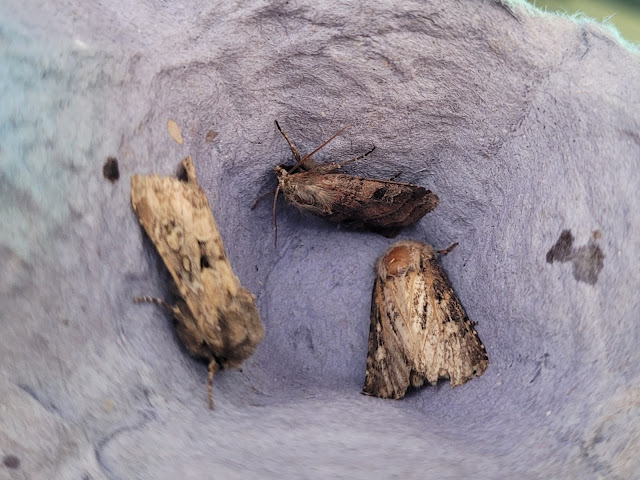 |
| Small Square Spot and Flounced Rustics |
 |
| Straw Underwing |
 |
| L-album Wainscot |
 |
Toadflax Pug
|
 |
| Willow Beauty |
We met at 8.30 at Kessingland and soon the party was
assembled. Antony was immediately in Moth mine mode and found the blotch and
fold on Hop of a newly colonising species – Caloptilia fidela while the poorly
Horse Chestnuts were infested with clouds of displaying Cameraria ohridella
which is actually a very pretty little moth when you get close to one. Ivy Bees thronged on the strongly scented Ivy
flowers and the first Hummingbird Hawkmoth of the day was on Valerian in a front
garden and we soon found a second once we were down on the beach and walking
south.
 |
| Caloptilia fidela |
 |
| Cameraria ohridella - mines and micro mothlets! |
Cameraria ohridella - a little video from Antony
 |
| Hummingbird Hawkmoth |
This was another random non specific bird related choice for
a start point but once again it was seemingly home to a Wryneck which was the
species that Helen really wanted to see.
The walk along the sandy greensward gave us the chance to check the
brambles and shrubs for migrants but it was hard going and by the time we got
all the way down to the sluice we had seen a good few Wheatears, a dapper Whinchat
and a couple of Stonechat but only three Whitethroat and no other
warblers.
 |
| Wheatear |
 |
| Wheatear |
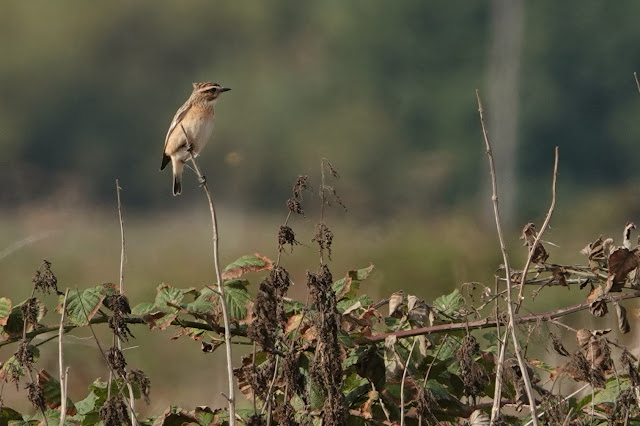 |
| Whinchat |
 |
| Whinchat |
Swallows and House Martins powered south in small groups and
a single Swift looked odd amongst them.
Linnets, Goldfinches and Greenfinches were amongst the Blackberries and
Dunnocks were audible and mobile with several circling up before dropping back
to cover. Whether these are actual
migrants of youngsters attempting to disperse down the coast I am not sure but
it was educational for the others to try and identify and silent circling
Dunnock from below. A few gulls drifted south and I picked up a young Caspian Gull amongst them much to Peter's surprise and delight.
The sea was unfortunately completely devoid of life despite
the similar conditions and wind direction of the last few days that had brought
Skuas and Shearwaters closer to shore.
There were just a few gulls, a couple of Cormorants and not a single
Tern. It was all rather odd.
 |
| Benacre Pits |
The spot where the Wryneck had been see the previous day was
about half a mile beyond the sluice around the farm beyond Benacre Pits (which
had water but no birds). I though I
heard a Dartford Warbler in a gully of Heather and Gorse but it did not call
again. Three Kestrel played along the
beach front area and a Sparrowhawk came in off while a second female almost
took one of the extra Wheatears that we discovered.
 |
| Donkey had the right idea with the shade |
I had not walked down here for over 30 years but had a
sneaky feeling once up at the farm that it was where I saw my only Eastern
Olivaceous Warbler way back in August 1995. Local young Swallows were lingering
around the farmyard and its paddocks along with a couple of glowing Stock Doves
but a couple of Chiffchaffs were the only addition.
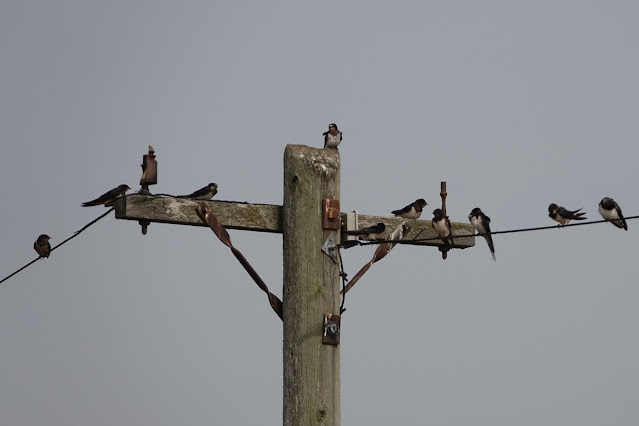 |
| Swallows |
 |
| Duke of Argyll's Tea Plant |
A local news ‘ping’ alerted us to the fact that the Wryneck
was still there and we were almost on top of it and a short while later we
found ourselves on the correct track by the Pill Boxes with the original
finders waiting for it to pop back out on the sandy track. Thankfully it did just that and over the next
forty minutes we had some excellent if somewhat brief views as it came down to
feed in the weedy median strip. It was not pushed but seldom stayed down for a
more than a minute before retreating to the windblown hedge and starting the
process all over again.
A party of about 40 House Martins dashed south and a
solitary Whimbrel did likewise. The walk
back was swifter and we got good views of the Wheatears again and a third
Hummer laying eggs on the Ladies Bedstraw in the microdunes. It was seriously warm again and lunch was
taken in the shade in the car park before decided to move back north to Lowestoft
where a few more Chats and a Redstart had been seen.
 |
| I do love a good sign |
The old fishing net drying beams were home to at least 12
Wheatears and a single Whinchat and the wooden structures lent themselves to
some good views and arty shots. A couple
of White Wagtails scurried around as we followed the board walk to the sea wall
just north of Ness Point where I could already see Med Gulls drifting around.
 |
| Wheatear |
 |
| Wheatear |
 |
| Wheatear - Uber Arty Antony |
 |
| Med Gull |
 |
| Felt like a White Wag |
 |
| Meadow Grasshopper |
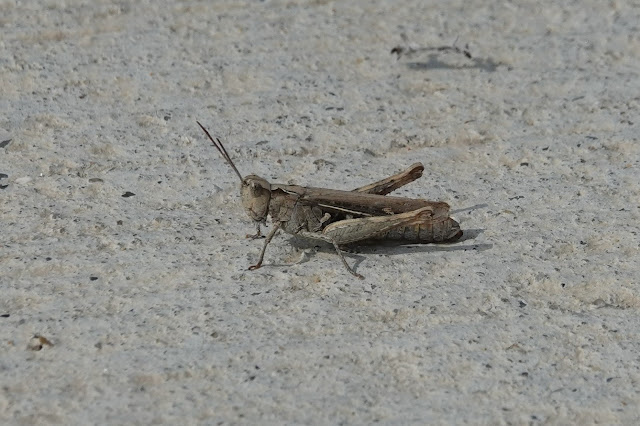 |
| Field Grasshopper |
.JPG) |
| Small Ranunculus on Wild Lettuce |
The six of us stood staring out to sea where nothing was
happening when a huge wave snuck up under the wall and sent a curtain of water
most of the way across the Prom. We mostly managed to turn away in time but we
still all got wet, and laughing, retreated to the first bench to dry out in the
now full on ‘summer sun’.
 |
| Burning up the Prom |
Still nothing moved, a bull Grey Seal bobbed by and a couple
of Common Terns fished close in and it took some judicious morsel lobbing to
get the gulls to come closer although only one Med, a second winter,
obliged. Most were juv Herring but one 2nd
year brute confused me and the jury is still out although I am leaning towards
Yellow-legged and have asked for some help.
 |
| Common Tern - moulting adult |
 |
| juv Herring Gull |
 |
| juv Herring Gull |
 |
| ad Herring Gull |
 |
| Not sure on this brute yet - almost GBBG but then feels like huge YLG |
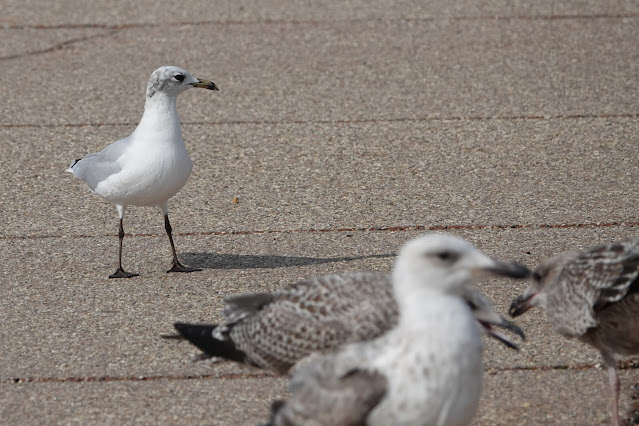 |
| 2nd winter Med Gull |
 |
| 2nd winter Med Gull |
 |
| 2nd winter Med Gull |
 |
| 2nd winter Med Gull |
 |
| Black-headed Gull |
A random bump into a pair of Senior Bradnums was a pleasant surprise
on the Prom before a last failed look for the Redstart and at the Wheatears on
their poles.
 |
| Wheatear |
 |
| Wheatears and Whinchat and haze! |
 |
| Wheatear |
 |
| Wheatear |
It was just gone three and
ridiculously hot so we called it a day and then retreated to Martello café in
Sparrows Nest Park for a cream tea and a good natter with bonus Goldcrest and
Coal Tit before a fine roast dinner at the Wrens to seen me on my way finally
home.



































.jpg)
.jpg)

























.JPG)
















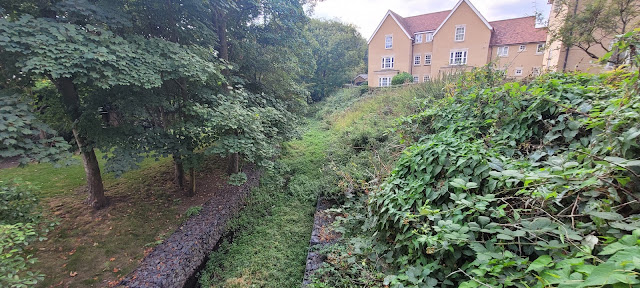

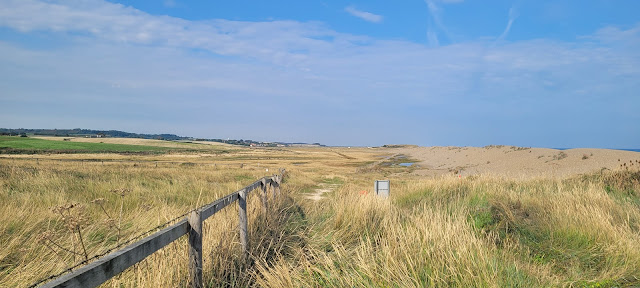


















No comments:
Post a Comment